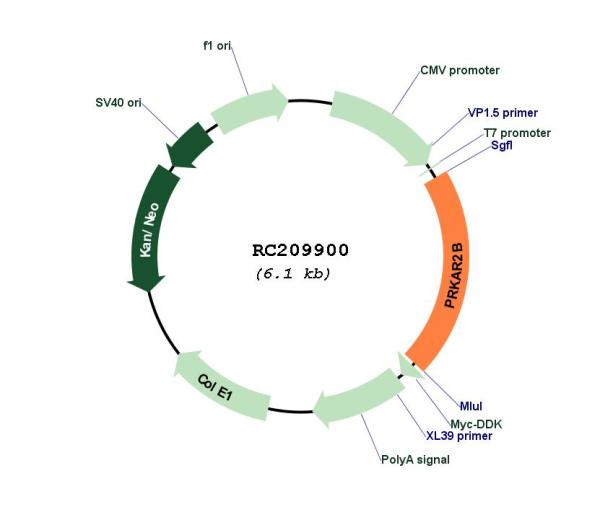PRKAR2B (NM_002736) Human Tagged ORF Clone
CAT#: RC209900
PRKAR2B (Myc-DDK-tagged)-Human protein kinase, cAMP-dependent, regulatory, type II, beta (PRKAR2B)
ORF Plasmid: tGFP
Lentiviral Particles: DDK w/ Puro mGFP w/ Puro
"NM_002736" in other vectors (4)
USD 198.00
Specifications
| Product Data | |
| Type | Human Tagged ORF Clone |
| Tag | Myc-DDK |
| Symbol | PRKAR2B |
| Synonyms | PRKAR2; RII-BETA |
| Vector | pCMV6-Entry |
| E. coli Selection | Kanamycin (25 ug/mL) |
| Mammalian Cell Selection | Neomycin |
| Sequence Data |
>RC209900 ORF sequence
Red=Cloning site Blue=ORF Green=Tags(s) TTTTGTAATACGACTCACTATAGGGCGGCCGGGAATTCGTCGACTGGATCCGGTACCGAGGAGATCTGCC GCCGCGATCGCC ATGAGCATCGAGATCCCGGCGGGACTGACGGAGCTGCTGCAGGGCTTCACGGTGGAGGTGCTGAGGCACC AGCCCGCGGACCTGCTGGAGTTCGCTCTGCAGCACTTCACCCGCCTGCAGCAGGAGAACGAGCGCAAAGG CACCGCGCGCTTCTGCCATGAGGGCAGGACCTGGGGGGACCTGGGCGCCGCTGCCGGGGGCGGCACCCCC AGCAAGGGGGTCAACTTCGCCGAGGAGCCCATGCAGTCCGACTCCGAGGACGGGGAGGAGGAGGAGGCGG CGCCCGCGGACGCAGGGGCGTTCAATGCTCCAGTAATAAACCGATTCACAAGGCGTGCCTCAGTATGTGC AGAAGCTTATAATCCTGATGAAGAAGAAGATGATGCAGAGTCCAGGATTATACATCCAAAAACTGATGAT CAAAGAAATAGGTTGCAAGAGGCTTGCAAAGACATCCTGCTGTTTAAGAATCTGGATCCGGAGCAGATGT CTCAAGTATTAGATGCCATGTTTGAAAAATTGGTCAAAGATGGGGAGCATGTAATTGATCAAGGTGACGA TGGTGACAACTTTTATGTAATTGATAGAGGCACATTTGATATTTATGTGAAATGTGATGGTGTTGGAAGA TGTGTTGGTAACTATGATAATCGTGGGAGTTTCGGCGAACTGGCCTTAATGTACAATACACCCAGAGCAG CTACAATCACTGCTACCTCTCCTGGTGCTCTGTGGGGTTTGGACAGGGTAACCTTCAGGAGAATAATTGT GAAAAACAATGCCAAAAAGAGAAAAATGTATGAAAGCTTTATTGAGTCACTGCCATTCCTTAAATCTTTG GAGTTTTCTGAACGCCTGAAAGTAGTAGATGTGATAGGCACCAAAGTATACAACGATGGAGAACAAATCA TTGCTCAGGGAGATTCGGCTGATTCTTTTTTCATTGTAGAATCTGGAGAAGTGAAAATTACTATGAAAAG AAAGGGTAAATCAGAAGTGGAAGAGAATGGTGCAGTAGAAATCGCTCGATGCTCGCGGGGACAGTACTTT GGAGAGCTTGCCCTGGTAACTAACAAACCTCGAGCAGCTTCTGCCCACGCCATTGGGACTGTCAAATGTT TAGCAATGGATGTGCAAGCATTTGAAAGGCTTCTGGGACCTTGCATGGAAATTATGAAAAGGAACATCGC TACCTATGAAGAACAGTTAGTTGCCCTGTTTGGAACGAACATGGATATTGTTGAACCCACTGCA ACGCGTACGCGGCCGCTCGAGCAGAAACTCATCTCAGAAGAGGATCTGGCAGCAAATGATATCCTGGATT ACAAGGATGACGACGATAAGGTTTAA >RC209900 protein sequence
Red=Cloning site Green=Tags(s) MSIEIPAGLTELLQGFTVEVLRHQPADLLEFALQHFTRLQQENERKGTARFCHEGRTWGDLGAAAGGGTP SKGVNFAEEPMQSDSEDGEEEEAAPADAGAFNAPVINRFTRRASVCAEAYNPDEEEDDAESRIIHPKTDD QRNRLQEACKDILLFKNLDPEQMSQVLDAMFEKLVKDGEHVIDQGDDGDNFYVIDRGTFDIYVKCDGVGR CVGNYDNRGSFGELALMYNTPRAATITATSPGALWGLDRVTFRRIIVKNNAKKRKMYESFIESLPFLKSL EFSERLKVVDVIGTKVYNDGEQIIAQGDSADSFFIVESGEVKITMKRKGKSEVEENGAVEIARCSRGQYF GELALVTNKPRAASAHAIGTVKCLAMDVQAFERLLGPCMEIMKRNIATYEEQLVALFGTNMDIVEPTA TRTRPLEQKLISEEDLAANDILDYKDDDDKV |
| Chromatograms |
CHROMATOGRAMS
 Sequencher program is needed, download here. |
| Restriction Sites |
SgfI-MluI
Cloning Scheme for this gene
Plasmid Map

|
| ACCN | NM_002736 |
| ORF Size | 1254 bp |
| OTI Disclaimer | Due to the inherent nature of this plasmid, standard methods to replicate additional amounts of DNA in E. coli are highly likely to result in mutations and/or rearrangements. Therefore, OriGene does not guarantee the capability to replicate this plasmid DNA. Additional amounts of DNA can be purchased from OriGene with batch-specific, full-sequence verification at a reduced cost. Please contact our customer care team at custsupport@origene.com or by calling 301.340.3188 option 3 for pricing and delivery. The molecular sequence of this clone aligns with the gene accession number as a point of reference only. However, individual transcript sequences of the same gene can differ through naturally occurring variations (e.g. polymorphisms), each with its own valid existence. This clone is substantially in agreement with the reference, but a complete review of all prevailing variants is recommended prior to use. More info |
| OTI Annotation | This clone was engineered to express the complete ORF with an expression tag. Expression varies depending on the nature of the gene. |
| Product Components | The ORF clone is ion-exchange column purified and shipped in a 2D barcoded Matrix tube containing 10ug of transfection-ready, dried plasmid DNA (reconstitute with 100 ul of water). |
| Reconstitution | 1. Centrifuge at 5,000xg for 5min. 2. Carefully open the tube and add 100ul of sterile water to dissolve the DNA. 3. Close the tube and incubate for 10 minutes at room temperature. 4. Briefly vortex the tube and then do a quick spin (less than 5000xg) to concentrate the liquid at the bottom. 5. Store the suspended plasmid at -20°C. The DNA is stable for at least one year from date of shipping when stored at -20°C. |
| Reference Data | |
| RefSeq | NM_002736.3 |
| RefSeq Size | 3678 bp |
| RefSeq ORF | 1257 bp |
| Locus ID | 5577 |
| UniProt ID | P31323 |
| Cytogenetics | 7q22.3 |
| Domains | cNMP, RIIa |
| Protein Families | Druggable Genome |
| Protein Pathways | Apoptosis, Insulin signaling pathway |
| MW | 46.3 kDa |
| Gene Summary | cAMP is a signaling molecule important for a variety of cellular functions. cAMP exerts its effects by activating the cAMP-dependent protein kinase, which transduces the signal through phosphorylation of different target proteins. The inactive kinase holoenzyme is a tetramer composed of two regulatory and two catalytic subunits. cAMP causes the dissociation of the inactive holoenzyme into a dimer of regulatory subunits bound to four cAMP and two free monomeric catalytic subunits. Four different regulatory subunits and three catalytic subunits have been identified in humans. The protein encoded by this gene is one of the regulatory subunits. This subunit can be phosphorylated by the activated catalytic subunit. This subunit has been shown to interact with and suppress the transcriptional activity of the cAMP responsive element binding protein 1 (CREB1) in activated T cells. Knockout studies in mice suggest that this subunit may play an important role in regulating energy balance and adiposity. The studies also suggest that this subunit may mediate the gene induction and cataleptic behavior induced by haloperidol. [provided by RefSeq, Jul 2008] |
Documents
| Product Manuals |
| FAQs |
| SDS |
Resources
Other Versions
| SKU | Description | Size | Price |
|---|---|---|---|
| RC209900L3 | Lenti ORF clone of Human protein kinase, cAMP-dependent, regulatory, type II, beta (PRKAR2B), Myc-DDK-tagged |
USD 986.00 |
|
| RC209900L4 | Lenti ORF clone of Human protein kinase, cAMP-dependent, regulatory, type II, beta (PRKAR2B), mGFP tagged |
USD 986.00 |
|
| RG209900 | PRKAR2B (tGFP-tagged) - Human protein kinase, cAMP-dependent, regulatory, type II, beta (PRKAR2B) |
USD 886.00 |
|
| SC125501 | PRKAR2B (untagged)-Human protein kinase, cAMP-dependent, regulatory, type II, beta (PRKAR2B) |
USD 686.00 |
{0} Product Review(s)
Be the first one to submit a review






























































































































































































































































 Germany
Germany
 Japan
Japan
 United Kingdom
United Kingdom
 China
China





